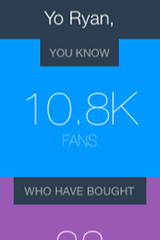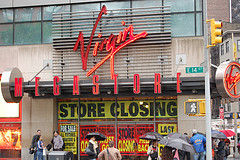Music Artists Routinely Give Away Their Most Valuable Resource and Don’t Even Realize It
 I’ve been thinking a lot about music artists and community recently, thanks to Ryan Leslie and Nathan McCartney of Disruptive Multimedia. They are on a mission to convince music artists of the value of connecting directly with fans. When I listen to them, I really believe they are trying to get artists to understand the value of actively managing your community.
I’ve been thinking a lot about music artists and community recently, thanks to Ryan Leslie and Nathan McCartney of Disruptive Multimedia. They are on a mission to convince music artists of the value of connecting directly with fans. When I listen to them, I really believe they are trying to get artists to understand the value of actively managing your community.
The sad fact is that most music artists are all too happy to hand their community over to a third party and lose the direct connection. When you send a fan to iTunes to buy an album, iTunes keeps 30% of the revenue – and 100% of the relationship. The revenue cut isn’t a big deal, but the relationship is everything.
And yet that is what most artists do when they try to sell music. They send people to iTunes. They transfer the relationship to Apple, who knows everything about the buyer. Meanwhile, the artist knows nothing. Too many artists are accepting of this arrangement. Data is power, and Apple holds the power. But it doesn’t have to be that way.
What If the Artist Held That Power?
What if you could, at any moment, pull up a list of fans who have actually paid you for music, merchandise and tickets? And not just a list of names, but data that helped you succeed as an artist and better serve your community of supporters? For example:
- What if you knew how much each fan has spent? You could then identify the fans who have financially supported you the most and recognize them.
- What if you knew how much has been spent by fans in or around a specific city? This would allow you to more effectively plan your tour. Who knew you had so many paying fans in that city? Well, you didn’t – until you saw the data.
- What if you had an easy way of contacting specific groups of fans with near certainty that they’d see your message? Let’s say you are doing a show in Pittsburgh. Wouldn’t it be great to send a text to your biggest fans in and around Pittsburgh, who you know bought your last album?
These are all very powerful uses of data, and they are exactly what you give away when you blindly send people to iTunes.
And it’s not an anti-iTunes thing. People expect to be able to buy music on iTunes. Therefore, it makes sense to have your music available on iTunes. But what doesn’t make sense is telling fans to go there, as the preferred place to buy your music. When you have the attention of a fan or potential fan – whether you are meeting them after a show, talking on Twitter or sending a message to your email list – you should be sending them to a store that you control.
It has been possible to do this for a while, but it hasn’t been this easy. That’s what impresses me about Disruptive Multimedia. The software brings a lot of tools together in a single, easy to use dashboard, giving you full ownership of your customer (paying fan) data.
Independent or Not, Data is Power
A lot of aspiring music artists have a single dream: get signed to a label. Unfortunately, some of these artists take a really short term view to their career. If they get enough YouTube views, if they get enough Twitter followers, if their mixtape is downloaded enough times, they’ll get an offer. Or that’s what they hope.
I don’t think getting signed is a particularly great goal. But even if that is your dream, the offer you receive from a label is contingent on the leverage you have. Without leverage, you have nothing. And while Twitter followers and YouTube views are nice, money is what matters most. Record labels exist to make money. An artist that doesn’t need a label to make money is an artist that negotiates from a position of strength, instead of weakness. The less you need a label, the more a label will want you.
At the same time, for many artists, a label offer will never come. And even if it did come, it may not be in your best interest. It is easier than ever to reach your fans directly. Many great artists are opting to sell their work directly to fans and supporters. By cutting out the label, they are able to keep more of the money and maintain greater creative control.
Even if you are already signed or never want to be, leverage matters when you negotiate with any potential business partner. Looking for a tour sponsor? Well, if you can show them how engaged your community is, that’s going to work in your favor, too. It’s OK to say “I was in the top 10 of the iTunes indie rock chart for 3 days!” It’s much better to say “I have at least 200 paying fans in each of these 13 cities. I can contact these fans the day I announce my tour.”
Reliance on Third Parties Makes You Vulnerable

Credit: Rebecca Wilson (CC BY 2.0)
When you rely solely on Facebook, Twitter, iTunes and other third parties to connect you with your community, you are exposing yourself to substantial, unnecessary risk. Facebook owns facebook.com/you. Twitter owns twitter.com/you. iTunes owns your iTunes artist page. Never lose sight of that.
This means two things. First, they can cut you off at any time. You can’t take your Twitter followers with you. You just lose them. So if the only place you are interacting with your fans is Twitter, your connection to your fans is gone if Twitter goes away, is down temporarily or suspends your account. Second, it means that you are beholden to the platform and can only engage in the manner that it allows.
For example, Facebook cut the organic reach of Facebook pages earlier this year. In other words, Facebook pages (like an artist page) started showing up a lot less when the average person visited Facebook. Some Facebook page managers complained about this. But really, it was their own fault. They relied too heavily on Facebook, instead of building their own database.
On a related note, when you send out a tweet, most of your followers don’t see it. Want proof? Login to your Twitter account and go to analytics.twitter.com. Click on a recent tweet you sent with a link to your music. The stats are right there in front of you. Impressions are the number of times a tweet was viewed. The link clicks number represents the number of times the link to your music was clicked. Look at those numbers and consider how many followers you have and how many followers never saw that tweet, let alone clicked to hear your music.
Now, this doesn’t mean you shouldn’t use Facebook, Twitter or similar services. You absolutely should. You should provide value to your fans on those platforms. But you should also be promoting your own website or store, encouraging people to connect with you directly. That way, you are building your own list and communicating with fans on your own terms in a way that no one can take away from you.
Your community will always be splintered across numerous platforms and services. The idea is to make sure that your most engaged supporters – your biggest fans – are connecting to you directly, not through an intermediary.
Being Release Driven vs. Community Driven
Record labels are very release driven. There is a cycle, and it revolves around the release of your album. The promotion machine kicks into gear for a relatively short period of time before your release and then it tapers off a relatively short period of time after. Unless you are Taylor Swift, you aren’t releasing singles for a year. You are pretty much done in a few months, max. And then you don’t exist for a while.
This is why so many artists “disappear.” It isn’t usually because of some big, bad record executive or because their contract was bad. It’s just simple math. They didn’t move enough units in the small window of time that the label provided for. They don’t get another window. That’s it. Most major label artists never release a second album (and many never release a first one).
The release cycle makes sense to labels. They have other artists, more projects and limited staff. But it’s bad for the artist. Artists can’t afford to be release driven. Artists who are release driven fall behind. They (and their people) have to be community driven.
Being community driven means that you are interacting with your fans not only when you have something to sell, but in the gaps in between. You are maintaining those connections and building those relationships. You are serving your community of supporters that allows you to do this for a living. The work that you put in, when you don’t have something to sell, builds the loyalty that brings people back when you ask for their money.
Some artists truly don’t care. They just want to make “good music,” and since they make “good music,” people will buy it. And if they don’t, it’s not the artist’s fault. It is the fault of the people. The artist is ahead of their time or misunderstood or whatever. Good luck with that mindset. You need to cultivate your fanbase. You need to make sure that your fans know you appreciate them. You do that by interacting with them and making time for them, just like you make time to record. In a very noisy world, the fans you should appreciate, first and foremost, are your patrons.
To use a tool like Disruptive Multimedia and make it work, you have to keep that core principle in mind. Sales of recorded music have fallen drastically since their peak in the late 1990s, but there is so much opportunity today, for the average artist to earn a living. The playing field has been leveled in many ways. But that doesn’t mean it’s easy. Smart software can help, but you still need the drive and determination. You still have to work for it.
You can’t just create great art and expect everyone to find it, appreciate it and give you money. You have to build your community, one person at a time.
